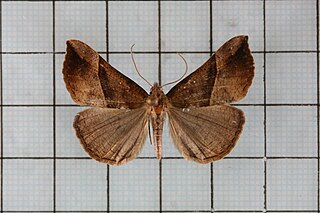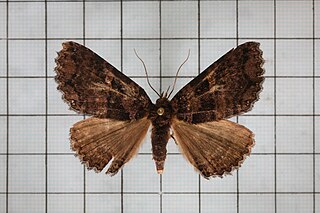
The Noctuidae, commonly known as owlet moths, cutworms or armyworms, are a family of moths. They are considered the most controversial family in the superfamily Noctuoidea because many of the clades are constantly changing, along with the other families of the Noctuoidea. It was considered the largest family in Lepidoptera for a long time, but after regrouping Lymantriinae, Catocalinae and Calpinae within the family Erebidae, the latter holds this title now. Currently, Noctuidae is the second largest family in Noctuoidea, with about 1,089 genera and 11,772 species. This classification is still contingent, as more changes continue to appear between Noctuidae and Erebidae.

Noctuoidea is the superfamily of noctuid or "owlet" moths, and has more than 70,000 described species, the largest number of any Lepidopteran superfamily. Its classification has not yet reached a satisfactory or stable state. Since the end of the 20th century, increasing availability of molecular phylogenetic data for this hugely successful radiation has led to several competing proposals for a taxonomic arrangement that correctly represents the relationships between the major lineages.

The genus Calyptra is a group of moths in subfamily Calpinae of the family Erebidae. They are a member of the Calpini tribe, whose precise circumscription is uncertain but which includes a number of other fruit-piercing or eye-frequenting genera currently classified in Calpinae.

The Calpinae are a subfamily of moths in the family Erebidae described by Jean Baptiste Boisduval in 1840. This subfamily includes many species of moths that have a pointed and barbed proboscis adapted to piercing the skins of fruit to feed on juice, and in the case of the several Calyptra species of vampire moths, to piercing the skins of mammals to feed on blood. The subfamily contains some large moths with wingspans longer than 5 cm (2 in).

Condicinae is a subfamily of moths in the family Noctuidae. The subfamily was erected by Robert W. Poole in 1995.

Hypospila is a genus of moths in the family Erebidae. The genus was erected by Achille Guenée in 1852.

Spodoptera is a genus of moths of the family Noctuidae erected by Achille Guenée in 1852. Many are known as pest insects. The larvae are sometimes called armyworms. The roughly thirty species are distributed across six continents.

Sypna is a genus of moths in the family Erebidae. The genus was erected by Achille Guenée in 1852.
Calyptra bicolor is a moth of the family Erebidae. It is found in India. It has been known to feed on humans, as well as a variety of other mammals.
Calyptra eustrigata is a moth of the family Erebidae, found in Sri Lanka and Malaysia. It has been reported as exhibiting parasitic blood-sucking behavior.

Calyptra fletcheri is a moth of the family Erebidae. It has been found in China.
Calyptra fasciata is a moth of the family Erebidae. It is found in India. It has been known to feed on humans, as well as a variety of other mammals.
Calyptra gruesa is a moth of the family Erebidae. It has been found in China. C. gruesa has a wingspan range of 25 to 29 millimetres.
Calyptra hokkaida is a moth of the family Erebidae. It has been found in China and Japan. The larvae length of C. hokkaido is roughly 40 millimetres (1.6 in).
Calyptra lata is a moth of the family Erebidae. It has been found in Japan and far-east Russia. The larvae length of C. lata is roughly 45 millimetres (1.8 in).

Calyptra minuticornis, the vampire moth, is a moth of the family Erebidae. It has been found in Indonesia, Java, India, Sri Lanka, and Australasia.
Calyptra ophideroides is a moth of the family Erebidae. It is found in East Indies. It has been known to feed on humans, as well as a variety of other mammals.
Calyptra parva is a moth of the family Erebidae. It is found in India. It has been known to feed on humans, as well as a variety of other mammals.

Calyptra orthograpta is a moth of the family Erebidae. It has been found in China and India. It has been noted to be a relatively rare species.











